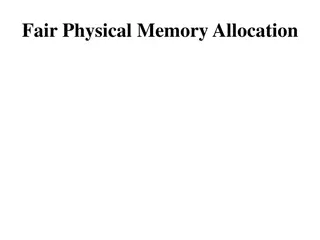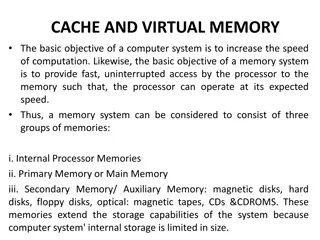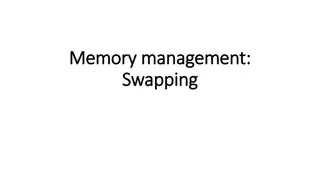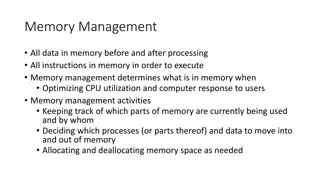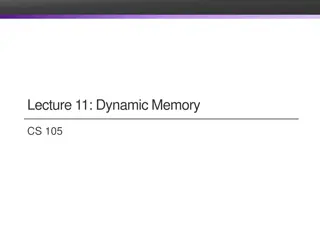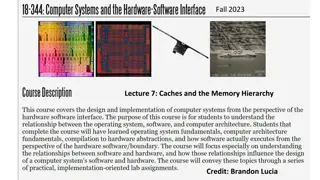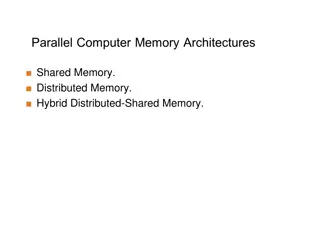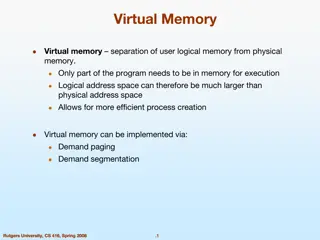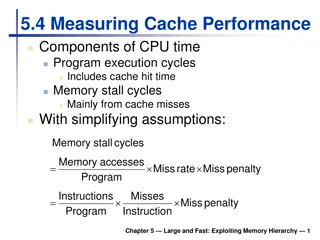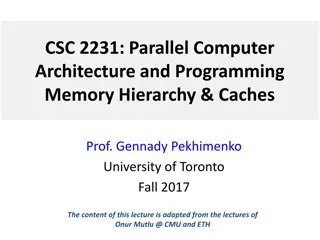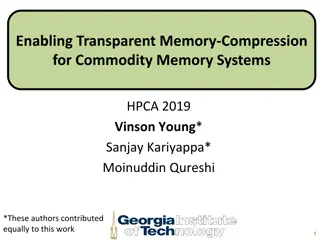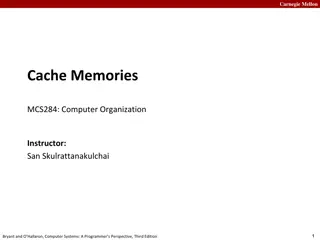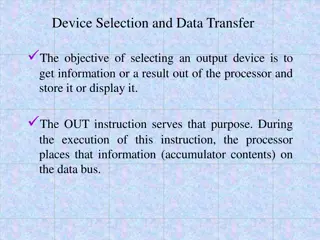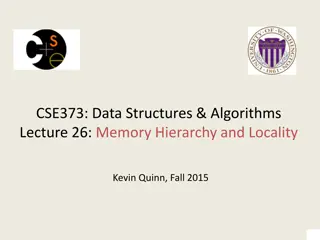Optimizing Memory Hierarchy for Efficient Performance
Today's lecture focuses on using SSE intrinsics to enhance performance through memory locality management and vectorization. Explore limitations, complications, and computational intensity in optimizing for the memory hierarchy, including discussions on matrix multiplication and computational intensity ratios.
Uploaded on Apr 19, 2025 | 0 Views
Download Presentation

Please find below an Image/Link to download the presentation.
The content on the website is provided AS IS for your information and personal use only. It may not be sold, licensed, or shared on other websites without obtaining consent from the author.If you encounter any issues during the download, it is possible that the publisher has removed the file from their server.
You are allowed to download the files provided on this website for personal or commercial use, subject to the condition that they are used lawfully. All files are the property of their respective owners.
The content on the website is provided AS IS for your information and personal use only. It may not be sold, licensed, or shared on other websites without obtaining consent from the author.
E N D
Presentation Transcript
Lecture 18 Optimizing for the memory hierarchy
Todays lecture Motivation for using SSE intrinsics Managing Memory Locality 2 Scott B. Baden / CSE 160 /Wi '16
Vectorization limitations If we have simple data dependence patterns, GCC can generate good quality vectorized code double a[N], b[N], c[N]; for (i=0; i<N; i++) { a[i] = sqrt(b[i] / c[i]); Speedup due to vectorization: x1.7 But for some loops it cannot, and must use the unpacked versions of SSE, effectively no SSE improvement The vectorizer cannot improve the performance of the cardiac simulator double *a, *b, *c; __m128d v1, v2,v3; for (i=0; i<N; i+=2) { v1 = _mm_load_pd(&b[i]); v2 = _mm_load_pd(&c[i]); v3 = _mm_div_pd(vec1,v2); v3 = _mm_sqrt_pd(v3); _mm_store_pd(&a[i], v3); } 3 Scott B. Baden / CSE 160 /Wi '16
Complications There was no benefit from vectorization Instead of using the packed form of instructions (128 bits) the code uses just the lower 64 bit protion of the xmm registers and the ALU: MULSD, MOVSD instead of MULPD andMOVAPD GCC can t vectorize this code How does it know that pointers Ep and Et don t overlap in memory? double **E, **E_prev; int jEnd = (((m+2)*(n+2) - 1) - n) - (n+2); for (j=n+2+1; j<= jEnd; j+=(n+2)){ double *Et = E + j, *Ep = E_prev + j; for (i=0; i < n ; i++) Et[i] = Ep[i]+?*(Ep[i+1]+Ep[i-1] - 4*Ep[i]+Ep[i+(n+2)]+Ep[i-(n+2)]); } 4 Scott B. Baden / CSE 160 /Wi '16
Todays lecture Motivation for using SSE intrinsics Managing Memory Locality 5 Scott B. Baden / CSE 160 /Wi '16
Computational Intensity Performance is limited by the ratio of computation performed and the volume of data moved between processor and main memory We call this ratio the computational intensity, or q; it is intrinsic to the application For example, for a conventional implementation of matrix multiplication q=2, but we can do much better 6 Scott B. Baden / CSE 160 /Wi '16
Matrix Multiplication An important core operation in many numerical algorithms Given two conforming matrices A and B, form the matrix product A B A is m n B is n p Operation count: O(n3) multiply-adds for an n n square matrix Discussion follows from Demmel 7 Scott B. Baden / CSE 160 /Wi '16
Memory access patterns i i = C A B n C(i,j) = k A(i,k) B(k,j) for i = 0 ton-1 for j = 0 ton-1 for k = 0 ton-1 C[i,j] += A[i,k] * B[k,j] 10 Scott B. Baden / CSE 160 /Wi '16
Analysis of performance for i = 0 to n-1 // for each iteration i, load all of B into cache for j = 0 to n-1 // for each iteration (i,j), load A[i,:] into cache // for each iteration (i,j), load and store C[i,j] for k = 0 to n-1 C[i,j] += A[i,k] *B[k,j] A[i,:] C[i,j] B[:,j] += * 11 Scott B. Baden / CSE 160 /Wi '16
Analysis of performance for i = 0 to n-1 // n n2 / L loads = n3/L, L=cache line size for j = 0 to n-1 // n2 / L loads = n2/L // n2 / L loads + n2 / L stores = 2n2 /L for k = 0 to n-1 C[i,j] += A[i,k] *B[k,j] B[:,:] A[i,:] C[i,j] Total:(n3 + 3n2) /L A[i,:] C[i,j] B[:,j] += * 12 Scott B. Baden / CSE 160 /Wi '16
Performance Performanceis good untilA&B no longerfit in L2cache 8+(N2 + N2 ) > 4MB Improvement:transposeB beforewe multiplyA*B, to avoid accessing B bycolumns Performancedrops when B no longerfits in L2: N ~ 725 Bimodal L1 missrate 33%and 4% forN=128,129 for i = 0 to n-1 for j = 0 to n-1 for k = 0 to n-1 C[i,j] += A[i,k] * BT[j,k]; L2 Cache Limit A /B Limit A[i,:] C[i,j] * += B[j,:] 13 Scott B. Baden / CSE 160 /Wi '16
How many cache lines are required to store a column of a 1282matrix? A. 128 B. 128 * 16 C. 128/64 Bang s Clovertown processor L1 is 32KB, 8 way set associative 64 byte linesize 512 bytes in a set, 64 sets total Row major 0 1 2 3 4 5 6 7 8 9 10 11 12 13 14 15 16 17 18 19 Patterson andHennessy 15 Scott B. Baden / CSE 160 /Wi '16
Cache behavior L1 is 32KB, 8 way set associative, 64 byte line size There are 512 bytes in a set, 64 sets total A1282matrix exceeds L1 s capacity Arowuses 16 cachelines ((128*8/64)),one afteranother one in eachset Acolumnneeds128 lines,spaced@ 16 lineintervals Therearen tenoughlines in all sets (128*16>> 64*8)so we evict a line and cannotreuse it whenwe getto the nextcolumn Row major 0 1 2 3 4 5 6 7 8 9 10 11 12 13 14 15 16 17 18 19 Patterson andHennessy 16 Scott B. Baden / CSE 160 /Wi '16
What happens when N=129? Matrix still doesn t fit into L1, but as you move down the column you ll be able to reuse some cached values Cache lines Row major 0 1 2 3 4 5 6 7 8 9 10 11 12 13 14 15 Column of matrix is stored in red cache lines Larry Carter 16 17 18 19 18 Scott B. Baden / CSE 160 /Wi '16
Blocking for cache: motivation The processor wastes a lot of time loading and re- loading B into cache Observation: if B fits in L2 cache, the code runs much more quickly Idea: what if we keep pieces of B in L2, and re-use them many times? 19 Scott B. Baden / CSE 160 /Wi '16
Blocked Matrix Multiply Divide A, B, C into N N sub blocks All 3 blocks must fit into cache Assume we have a good quality library to perform matrix multiplication on subblocks Each sub block is b b b=n/N is called the block size How do we establishb? A[i,k] C[i,j] C[i,j] = + * B[k,j] 21 Scott B. Baden / CSE 160 /Wi '16
What is the appropriate constraint for blocking for cache? A. All 3 blocks mustfit in cache B. OnlyA C. Only B D. Only A andB 22 Scott B. Baden / CSE 160 /Wi '16
Blocked Matrix Multiplication Constraints All 3 blocks must fit intocache If Mfast = size of fast memory (L1) 3b2 Mfast b (Mfast/3)1/2 for i = 0 to N-1 for j = 0 to N-1 // load each block C[i,j] into cache, once : n2 // b = n/N = block size for k = 0 to N-1 // load each block A[i,k] and B[k,j] N3times // = 2N3 (n/N)2 C[i,j] += A[i,k] B[k,j] // do the matrix multiply // write each block C[i,j] once : Total: 2Nn2 = n2 (2*N+2)*n2 A[i,k] C[i,j] C[i,j] = + * B[k,j] 23 Scott B. Baden / CSE 160 /Wi '16
Computational intensity Let q = # flops / main memory reference 2n3 n q = = (2N +2)n2 N +1 n/N = b as n Compare with q=2 for the unblocked algorithm! 24 Scott B. Baden / CSE 160 /Wi '16
Why will results vary according to the blocking factor? A. Floating point arithmeticisn t associative B. Roundoff C. Both 25 Scott B. Baden / CSE 160 /Wi '16
The results Where did the performance go? Compiler is unable to generate multiply-addinstructions, so the best we can do is 4.66 Gflops Clovertown supports simultaneous multiplication and addition L1 hit cost 3 cycles (3/8 cycle for each access to A, B andC) R = 4*2.33 = 9.32 Gflops ~13% of peak Access latency, throughput (clocks) 2-3 Core2 Core2 Core2 Core2 32K L1 32K L1 32K L1 32K L1 14 4MB 4MB Shared L2 Shared L2 150/600 FSB L2 Cache Limit 10.66 GB/s 26 Scott B. Baden / CSE 160 /Wi '16
Performance of Matrix Multiply 8.14 GFlops R = 4*2.33 = 9.32 Gflops ~87% ofpeak 27 Scott B. Baden / CSE 160 /Wi '16
The code for i := 0 to n-1 for j := 0 to n-1 for k := 0 to n-1 C[i,j] += A[i,k] *B[k,j] Recall the blockedalgorithm for (ii=0; ii<n; ii+=BSZ) for (jj=0; jj<n; jj+=BSZ){ // Initialize Cij to 0 for (int kk=0; kk<n; kk+=BSZ){ for (i=0; i<BSZ; i++){ for (j=0; j<BSZ; j++){ sum = 0; for (int k=0; k<BSZ; k++) sum += A[i+ii][k+kk] * B[k+kk][j+jj]; Cij[i][j] += sum; } } } for (i=0; i<BSZ; i++) for (j=0; j<BSZ; j++) C[i+ii][j+jj] += Cij[i][j]; } } 28 Scott B. Baden / CSE 160 /Wi '16
The assembler Run make withasm=1 for (int k=0; k<BSZ; k++) sum += A[i+ii][k+kk] *B[k+kk][j+jj]; See: cs.nyu.edu/courses/fall11/CSCI-GA.2130-001/x64-intro.pdf http://www.cs.virginia.edu/~evans/cs216/guides/x86.html .L11: mov movsd add **** cmp **** mulsd addsd rdx, QWORD PTR [rdi+rax*8] xmm0, QWORD PTR [rsi+rax*8] rax, 1 # ivtmp.52, for (int k=0; k<BSZ; k++) r15d,eax sum += A[i+ii][k+kk] *B[k+kk][j+jj]; xmm0, QWORD PTR [rdx+rcx] xmm1, xmm0 for (int k=0; k<BSZ;k++) .L11 #, # BSZ, ivtmp.52 # {Scalar multiply} # sum, D.3420 jg 29 Scott B. Baden / CSE 160 /Wi '16
Going the full distance 2 levels of cache blocking + Cache friendly layouts Use SSE Register blocking Autotuning Tune block size to matrix size Computer generated variants & blocking factors See www.cs.berkeley.edu/~demmel/cs267_Spr12/Lectures/lecture02_ memhier_jwd12.ppt Max: 7.87 Gflops Avg: 6.4 Gflops R = 4*2.33 = 9.32 Gflops 84% of peak(max) 69% peak(avg) H.Rodrigues, K.Korgaonkar,Y.Kim (CSE 260, W14) 30 Scott B. Baden / CSE 160 /Wi '16
Going the full distance R = 4*2.33 = 9.32 Gflops 84% of peak(max) 69% peak(avg) Max: 7.87 Gflops Avg: 6.4 Gflops H.Rodrigues, K.Korgaonkar,Y.Kim (CSE 260, W14) 31 Scott B. Baden / CSE 160 /Wi '16


